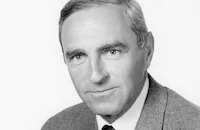Soylent Green

Brief Synopsis
Cast & Crew
Richard O. Fleischer
Charlton Heston
Leigh Taylor-young
Edward G. Robinson
Chuck Connors
Roy Jenson
Film Details
Technical Specs
Synopsis
New York City in the year 2022 the population is over 40 million. Without enough food to feed the masses--most of it must be manufactured in local factories. The dinner choices are between Soylent Blue, Soylent Yellow, or Soylent Green. When William Simonson an executive in the Soylent Company, is found murdered, police detective Thorn is sent in to investigate the case. As he delves deeper into his investigation he uncovers another dark secret-- the heinous truth behind the real ingredients of Soylent Green.
Cast

Charlton Heston

Leigh Taylor-young

Edward G. Robinson

Chuck Connors
Roy Jenson
Lincoln Kilpatrick
Stephen Young
Mike Henry

Whit Bissell

Brock Peters
Paula Kelly

Joseph Cotten
Leonard Stone
Crew
Pat Barto
Samuel E. Beetley
Robert R. Benton
Edward C Carfagno
Gerald Fried
Stanley R Greenberg
Harry Harrison
Robert R. Hoag
Richard Kline
Richard Kline
Augie Lohman
Daniel J. Mccauley
Fred Myrow
Walter Seltzer
Harry W. Tetrick
Russell Thatcher
Bud Westmore
Charles Wilborn
Sherry Wilson
Matthew Yuricich
Photo Collections
Videos
Movie Clip





Trailer
Hosted Intro



Film Details
Technical Specs
Articles
Soylent Green
Although Soylent Green remains one of the most popular science fiction films of the seventies (it won the much coveted Nebula Award), it did take several liberties with Harry Harrison's original novel, resulting in some major disagreements between the author and MGM, the studio that made the film. In the book, Omni's Screen Flights/Screen Fantasies, edited by Danny Peary, Harry Harrison discusses the mutilation of his novel in the following excerpt:
"As is standard Hollywood practice, the author of the book upon which this film is based was treated shabbily. All the usual tricks were used: a dummy company was set up to disguise the fact that it was really MGM buying the film rights; a contract was drawn up to prevent the author from having any control over the screenplay - and, of course, creative bookkeeping made certain none of the film's profits reached the author....Although forbidden by contract to make any changes in the script, I nevertheless pointed out a number of inaccuracies and mistakes I discovered....I propagandized everyone in sight, from grips to actors, by giving them copies of the original book. When Charlton Heston got his, he called across the set to the director (Richard Fleischer), 'Hey, Dick, why aren't you using this title instead of the crappy Soylent Green?' The answer, which Fleischer perhaps did not know, was the decision made in high places that my title might be associated with a long-dead TV series named 'Make Room for Daddy.' Moral: When you throw away a good title, you always get a bad one....The idiotic cannibal-crackers (not in the book) and the 'big' revelation that they are made from corpses will have been twigged by the audience early on. This, and the murder and chase sequences, the 'furniture' girls (not in the book) are not what the film is about - and are completely irrelevant. The film, like the book, shows what the world will be like if we continue in our insane manner to pollute and overpopulate Spaceship Earth. This is the 'message' of film and book. Both of them deliver this message in a manner unique to science fiction: The technique of background-as-foreground....Am I pleased with the film? I would say fifty percent. The message of the book has been delivered. It was an exciting experience to see a major film produced by a major studio. It was a humbling experience to meet Edward G. Robinson. A great actor and a great human being. He alone knew that he had terminal cancer when he made the film. He must have chosen to make one more film rather than sit quietly at home and await death. He died before the film was released and it is a tribute to the hard-nosed film executives that they did try to cut out the suicide-parlor scene before the film was released. But it is such an integral part of the film that it could not be done."
Since Soylent Green takes place in the near future where overpopulation has become mankind's curse, much of the set design was created to mimic New York City's extreme space problems in the 21st century. A certain aesthetic was designed to make every nook and cranny of the New York City streets look filled in with something, whether it is garbage, vehicles or people. Indeed, some of the "sets" are people themselves. Younger women are referred to as "furniture" and placed in apartments for men of privilege while people that can actually read are referred to as "books." The euthanasia death chamber was conceived as a sort of super IMAX movie theater where previously "forbidden" images such as forests, water, or mountains flash before the occupants' eyes in their dying moments.
In a career that spanned five decades, the art director of Soylent Green, Edward C. Carfagno, created many unique movie sets in his time, mostly for MGM. Carfagno earned Academy Awards for Best Art Direction for his work in The Bad and the Beautiful (1952), Julius Caesar (1953), and Ben-Hur (1959), while earning nominations for many more. He worked on an additional twenty-five films, many for actor-director Clint Eastwood, before his death in 1996.
And now for a quick bit of trivia about the director of Soylent Green - Richard Fleischer. Did you know he was the son of the famous animator Max Fleischer, the man who created Betty Boop and Koko the Clown? Do you know he also directed such fantasy and sci-fi favorites as 20,000 Leagues Under the Sea (1954), Fantastic Voyage (1966), Dr. Dolittle (1967), Conan the Destroyer (1984), and Red Sonja (1985)? Among his many movies, however, Soylent Green appears to be the popular cult favorite, and people still love to quote that unforgettable line from the film, "Soylent Green is PEOPLE!!!"
Director: Richard Fleischer
Producer: Walter Seltzer, Russell Thacher
Screenplay: Stanley R. Greenberg, Harry Harrison (based on his novel, Make Room! Make Room!
Cinematography: Richard H. Kline
Editing: Samuel E. Beetley
Music: Fred Myrow
Principal Cast: Charlton Heston (Police Detective Thorn), Leigh Taylor-Young (Shirl), Edward G. Robinson (Sol Roth), Chuck Connors (Tab Fielding), Joseph Cotten (William R. Simonson), Brock Peters (Lt. Hatcher), Mike Henry (Kulozik), Whit Bissell (Governor Santini), Dick Van Patten (Usher #1).
C-97m. Letterboxed. Closed captioning.
by Jeff Stafford

Soylent Green
Quotes
Who bought you?- Det. Thorn
You're bought as soon as they pay you a salary.- Hatcher
I know, Sol, you've told me a hundred times before. People were better, the world was better...- Det. Thorn
Ah, people were always lousy. But there was a world, once.- Sol
I was there, I can prove it! When I was a kid, you could buy meat anywhere! Eggs they had, real butter! Not this... crap!- Sol
Why, in my day, you could buy meat anywhere! Eggs they had, real butter! Fresh lettuce in the stores.- Sol
I know, Sol, you told me before.- Det. Thorn
Would you believe bodyguards are buying strawberries for 150 D's a jar?- Det. Thorn
You know what I really think, Lieutenant? I think it's really busted this time.- Det. Thorn
Trivia
The technical consultant for the film was Frank R. Bowerman, who was president of the American Academy for Environmental Protection at the time.
One of the scenes of the "beautiful earth" shown to Sol as he is dying is an opening shot from Far from the Madding Crowd (1967) (a flock of sheep on a green hillside).
Edward G. Robinson's last film.
The scene where Thorne and Roth share a meal of fresh food was not originally in the script, but was ad-libbed by Heston and Robinson at director Fleischer's request.
The videogame in Simonson's apartment, "Computer Space", was one of the first coin-operated videogames, manufactured by Nutting Associates in 1971 and designed by Nolan Bushnell, who later founded Atari and designed "Pong."
Miscellaneous Notes
Released in United States Spring May 9, 1973
Released in United States Spring May 9, 1973















